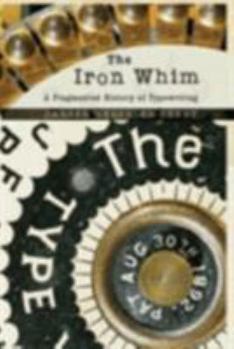The Iron Whim: A Fragmented History of Typewriting
Select Format
Select Condition 
Book Overview
The Iron Whim is an intelligent, irreverent, and humorous history of writing culture and technology. It covers the early history and evolution of the typewriter as well as the various attempts over the years to change the keyboard configuration, but it is primarily about the role played by this marvel in the writer's life. Darren Wershler-Henry populates his book with figures as disparate as Bram Stoker, Mark Twain, Franz Kafka, Norman Mailer,...
Format:Hardcover
Language:English
ISBN:0801445868
ISBN13:9780801445866
Release Date:April 2007
Publisher:Cornell University Press
Length:344 Pages
Weight:1.20 lbs.
Dimensions:1.1" x 5.8" x 8.8"
Age Range:18 years and up
Grade Range:Postsecondary and higher
Customer Reviews
3 ratings
Typewriting trivival history
Published by Thriftbooks.com User , 14 years ago
I bought this book because I needed to know more about the typewriter in occupation and enjoyment since I'm a history buff, and I learned about it at the Arlington University Typewriter Store up beyond North Cambridge, so I accessed Amamzon.com and located it - easy as pie! Thank you so much for helping me obtain this book - sincerely, Laura A F
True to its name, this book is fragmented and whimsical!
Published by Thriftbooks.com User , 15 years ago
Did you know that in 1857, Dr. Samuel Ward Francis invented a "printing machine" that looked like an abbreviated piano keyboard attached to a huge daisy wheel? You can find it on p. 58 in the book. Did you know that in the early days of typewriting, it was the humans, not the machines, that were known as "typewriters"? Wershler-Henry devotes several chapters just to the concept of dictation and amanuensis (look it up). Did you know that the concept of double-spacing after a period in a sentence can be pretty much ignored now, in this age of word processing? It's because characters in most word processing font types are proportionally spaced (not so in the old typewriters). So now, when you type a long paragraph in Word, for instance, you might notice what's called "rivering", as typographers call it -- the tendency for a stream of white to gulley down a page where all the doublespaces gather. Because we're adding space where it's no longer needed. Did you know that in the 1960s, Elisabeth Mann Borgese (daughter of Thomas Mann) taught her beloved English Setter (Arli) to "type"? He got up to a vocabulary of 60 words, using 17 letters. He even got to the point where he was communicating simple feelings about himself. Or so she imagined. You'll find his cute picture in the book, punching big oversized letter keys with his nose. Did you know that an experiment with a zillion chimpanzees typing several months non-stop eventually produced a real typewritten word? (It refers to one of our favorite holidays.) There was more. It had to do with Shakespeare... and Hamlet. This book has other fun tidbits, including glimpses at non-QWERTY keyboard configurations that failed to take off, such as the "Dvorak Simplified" keyboard. Oh, how we resist change, even when it makes sense! Think how little relevance QWERTY now has in this age of text-messaging, when we use phone-centric keypad arrangements. Did you know that the adding machine was invented by the grandfather of William S. Burroughs (another William S. Burroughs), famous novelist of such rambling and free-form cut-n-pasted texts ("cut-ups") as The Naked Lunch? Novelist Burroughs spoke about the "soft machine" and said, "Words don't belong to anyone... they have a vitality of their own." I like that. This brings to mind the famous mid-60s pop-art soft sculpture, "The Typewriter" by Claes Oldenburg. There's more too .. such as a discussion of the Dan Rather CBS cover-up incident with the doctored document on Bush's preferential treatment in the Texas Air National Guard. Well, "typewriter forensics" helped clear up that little lie. You might also like the description of the World War II enigma machine. Anyway, this book's packed with fun facts about that clickety-clackety machine and its typewriter tappers. It is a bit disjointed, but that's what makes it fun. Reading all about typewriting made me want to back-track and read about pencils. So I picked up a related book, The Pencil,
A facinating exploration of a fascinating subject
Published by Thriftbooks.com User , 17 years ago
This work is about a fascinating subject, especially I suspect to all those who have known the transition, first from the handwriting to the typing , and then from the typing to the word- processor modes of human expression. Wershler- Henry is interested in revealing to us the way the parts of the machine work together, and as he indicates the way to do this is to look at them when they have been discombobulated, when they are taken apart and seen not as the height of progress and invention, but as mere random pieces put together. Even more importantly he tells us his goal in writing this book is " to understand how typewriting shaped and changed not only Literature, but also our culture and sense of ourselves". He ranges over a wide variety of subjects and includes descriptions of how the typewriter influenced the writing lives of some of the great literary masters. He too surveys what the change from the relatively harder - work of typewriting to the smooth more soundless touch of computer keys means for us. His chapters are interestingly titled for example: Typewriting and Dictation, Typewriter Nostalgia, , Typewriting and Speed, Typewriting and Discipline, Writing Blind, Poet's Stave and Bar, Typewriters at War, Typewriting After the Typewriter. He certainly tells us more about 'typewriting' than we who for years stabbed and banged on our favorite instrument could have ever understood of its complexity and significance. Ah for my old Smith- Corona .





